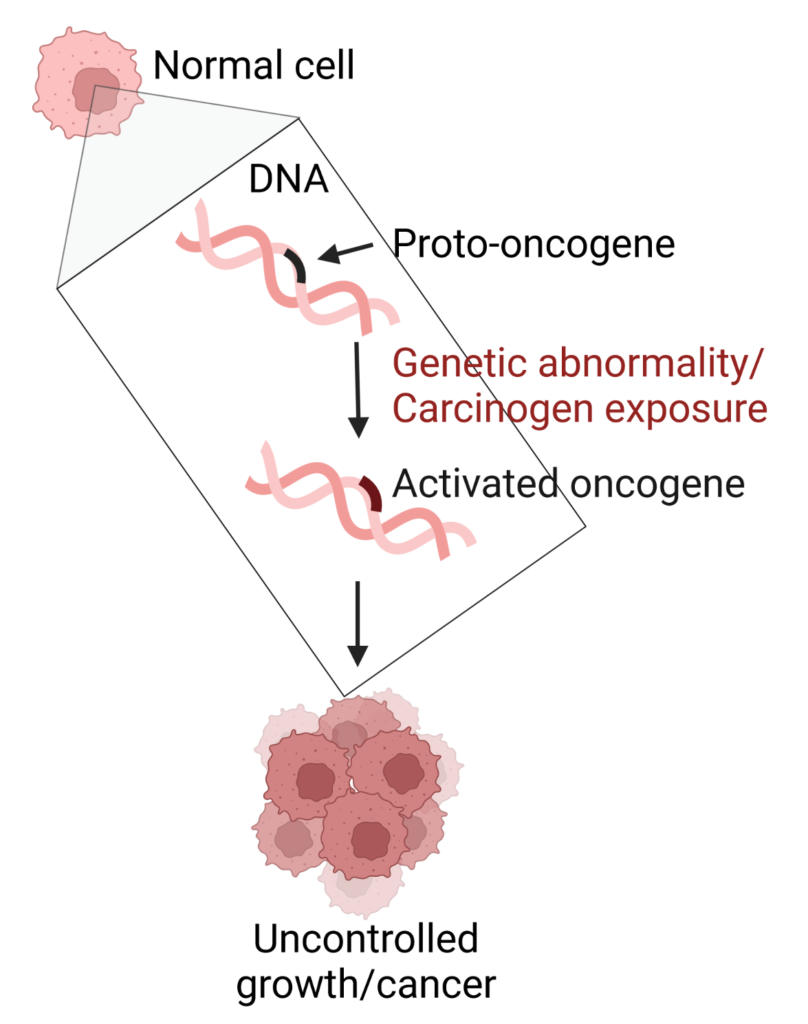by Deepika Jayaprakash
One major cause of human cancer development is the activation of certain genes known as proto-oncogenes. Proto-oncogenes are critical regulatory genes that promote normal cell growth and cell survival. During cancer development, the proto-oncogenes gain changes in their genetic sequence (mutations), which can be inherited or acquired due to cancer-causing agents like certain chemicals and radiation (carcinogens). When the proto-oncogenes acquire these harmful changes, they are called ‘oncogenes’, which have the ability to cause cancer (Figure 1).

Proto-oncogenes encode proteins that the cell needs for normal growth and survival. However, once they become oncogenes, they can code for a protein product which is 1000 times more active than the proto-oncogene protein product. Think of it like a car gas pedal constantly being pushed down. This means that the cells with these oncogenes keep multiplying faster and faster without any brakes, resulting in what we know as a tumor/cancer.
Oncogenes were first discovered in viruses. In 1909, a chicken with a tumor in breast tissue was presented to Dr. Francis Peyton Rous at the Rockefeller Institute in New York. Curious, Rous sought to find out if the tumor was transmissible to another bird (Figure 2). He took the cancer tissue, ground it with sand to break it into small particles, then filtered it to capture cancer cells and bacteria, allowing only viruses to pass through (owing to the smaller size of virus). He injected the filtered virus into another bird and observed that a tumor developed! Rous thought that the tumor in the bird was caused by a virus which was subsequently called ‘Rous sarcoma virus’ (RSV).

Rous’s discovery established the experimental methods to study cancer biology in the laboratory. But it was not until 1958 that Rous’s work got valid recognition when two other scientists, Temin and Rubin, demonstrated RSV’s ability to transform healthy cells grown in the laboratory into cancer cells. Rous was honored with a Nobel Prize in 1966 for his great discovery in the field of Physiology or Medicine.
Interestingly, further studies indicated that the filtrate-induced tumor was not caused by the virus itself but from a specific genetic information within the virus which was later named an oncogene. Additionally, Harold. E. Varmus and Michael. J.Bishop demonstrated that the oncogenes found in the viruses were not originally part of the virus, but derived from the genes of different organisms they infect. The two scientists received the Nobel prize in 1989 for this discovery.
This fascinating series of experiments that led to the discovery of oncogenes paved the way to explore roles of oncogenes in human cancer development.
Today, we know that about 12-20% of all human cancers are caused by viral infections driven by viral oncogenes. The virus hijacks the human cell machinery, allowing the viral oncogene to cause uncontrolled cell growth. Successful vaccines have been developed against certain cancer-causing viruses like hepatitis B virus (causes liver cancer) and human papilloma virus (causes cervical and oropharyngeal cancers), and there has been continual research to develop effective vaccines against others.
For the remaining >80% of cancers which are driven by human oncogenes (activated human proto-oncogenes), strict regulation is in place to identify and ban cancer-causing chemicals in industrial or domestic use. Research has led to the discovery of drugs to target and inhibit these oncogenes (eg: cetuximab which inhibits an oncogene called EGFR) and their associated regulators in cancer treatment.
With advanced experimental techniques and multiple great minds involved in research, mankind will soon be able to firmly apply brakes to ill-effects of oncogenes and stop cancer growth.
